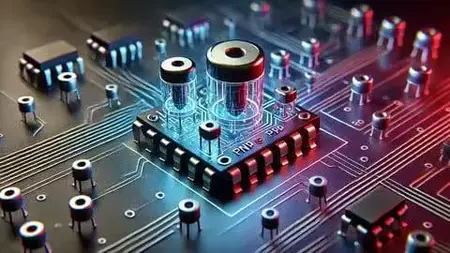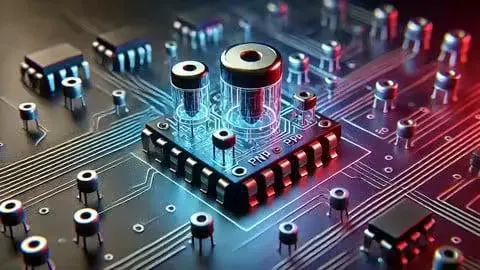Bipolar Junction Transistors: Part 1 - Fundamentals
Published 2/2025
MP4 | Video: h264, 1920x1080 | Audio: AAC, 44.1 KHz
Language: English | Size: 1.38 GB | Duration: 5h 33m
Published 2/2025
MP4 | Video: h264, 1920x1080 | Audio: AAC, 44.1 KHz
Language: English | Size: 1.38 GB | Duration: 5h 33m
Explore the comprehensive theoretical foundations and practical applications of transistors in this in-depth course
What you'll learn
Three-terminal Devices, History and Significance, Device Structure, Technical Jargons, Modes of Operation, Circuit Configurations, Types of Transistors
Advantages and Disadvantages, Common-base Configuration, Common-emitter Configuration, Common-collector Configuration, Circuit Configuration Relationships
Cutoff Mode of Operation, Current Flow Mechanism in Active Mode of Operation, Equivalent Model of Transistor in Active Region, Saturation Region of Operation
Static Characteristics, Drift Region, Output Characteristics, Early Effect, Quasi-saturation, Conductivity Modulation, Emitter Current Crowding
Switching Characteristics, Parasitic Capacitances, Miller Effect, Resistive Load Switching Characteristics, Inductive Load Switching Characteristics
Darlington Configuration, Power Losses, Parallel Operation, Single Quadrant Operation, Current Gain Dependencies, Base Spreading Resistance
Primary Avalanche Breakdown, Reach-through Breakdown, Second Breakdown
Ebers-Moll Model, Gummel Poon Model, LTSPICE Simulation of Transistor
Anatomy of Transistor Datasheet, Front Page, Absolute Maximum Ratings, Thermal Characteristics, Electrical Characteristics, Typical Characteristics
Ordering Information and Guide, Packaging Information and Mechanical Data, Thermal Model of Transistor, Forward-biased and Reverse-biased Safe Operating Areas
Transient Thermal Impedance, Applications of Transistors, Transistor Testing Methods, Interview Questions
Requirements
Basic Knowledge of Semiconductor Theory
Understanding of Basic Electrical Circuits
Proficiency in Basic Mathematics and Algebra
Genuine Interest in the Subject Matter
Description
Hello there!Welcome to my course titled "Bipolar Junction Transistors: Part 1 - Fundamentals"This comprehensive five-and-a-half-hour course establishes the necessary foundation of theoretical concepts related to both signal and power transistors. It bridges the gap between theory and practical applications, saving students significant time that would otherwise be spent reading multiple books to understand various concepts. The curriculum is thoughtfully structured to guide you from foundational principles to advanced concepts. To reinforce your learning, we provide knowledge-check quizzes and LTSpice simulation files at strategic points, enabling you to apply theoretical knowledge in practical scenarios. As the course culminates, you'll engage with thoughtfully curated interview questions designed to bolster your confidence and mastery of the subject matter.Course Curriculum:Module 1: Introduction to Bipolar Junction Transistors (BJTs)This module provides a surface-level understanding of transistors without delving into detailed mathematical equations.Module 2: Circuit ConfigurationsThis module explores various transistor circuit configurations, including common-base, common-emitter, and common-collector setups. We also highlight the most preferred configuration in electronic circuits and explain the reasons behind its preference. LTSpice simulation files are provided for the students to simulate the circuits at their convenience.Module 3: Operating MechanismsThis module discusses the operating mechanisms common to both signal and power transistors. LTSpice simulation files are provided for the students to simulate the circuits at their convenience.Module 4: Static I-V CharacteristicsThis module delves into the static I-V characteristics of transistors. Topics include emitter current crowding, quasi-saturation, and conductivity modulation, especially concerning power transistors.Module 5: Dynamic CharacteristicsThis module examines the dynamic switching characteristics of transistors in detail. We cover switching mechanisms for both resistive and inductive loads and provide detailed calculations of switching losses. LTSpice simulation files are provided for the students to simulate the circuits at their convenience.Module 6: Miscellaneous TopicsThis module covers various topics such as Darlington configuration, power losses, parallel operation, single quadrant operation, and base spreading resistance.Module 7: Breakdown MechanismsThis module explores breakdown mechanisms, including primary breakdown, second breakdown in power transistors, and reach-through breakdown.Module 8: Simulation ModelsThis module investigates simulation models of transistors, such as the Gummel-Poon Model, Ebers-Moll Model, and LTSpice default models.Module 9: Understanding Datasheet ParametersThis module discusses how to comprehend datasheet parameters by systematically exploring each section of a transistor datasheet.Module 10: Thermal CharacteristicsThis module provides deep insights into thermal impedance, transient thermal impedance, and the safe operating area of transistors.Module 11: Applications, Testing Methods, and Interview QuestionsThis module discusses various transistor applications, practical testing methods, and share insightful interview questions drawn from personal experience.Module 12: ConclusionThis module concludes our journey with additional transistor-related references.Throughout this course, you will build a strong and in-depth theoretical foundation necessary to master transistors.We hope you find this course engaging and enriching!Let's embark on this exciting learning journey!
Analog Circuit Design Engineers,All Electrical Engineering Students,Power Electronics and Power Converter Designers,Anyone Preparing for Job Interviews,Anyone Looking for a Quick Subject Revision



